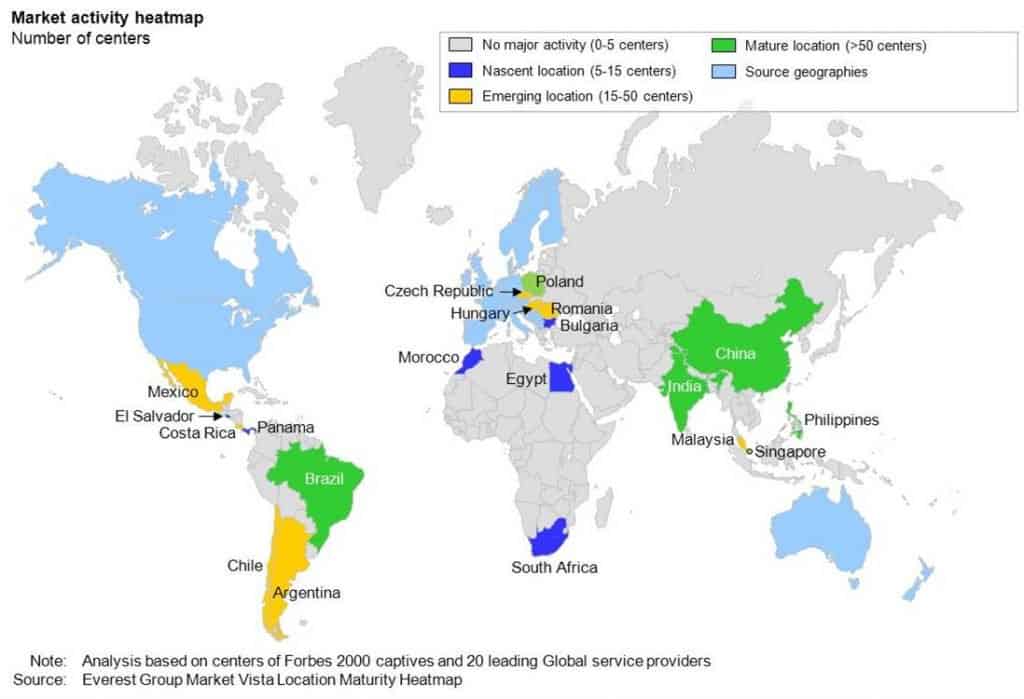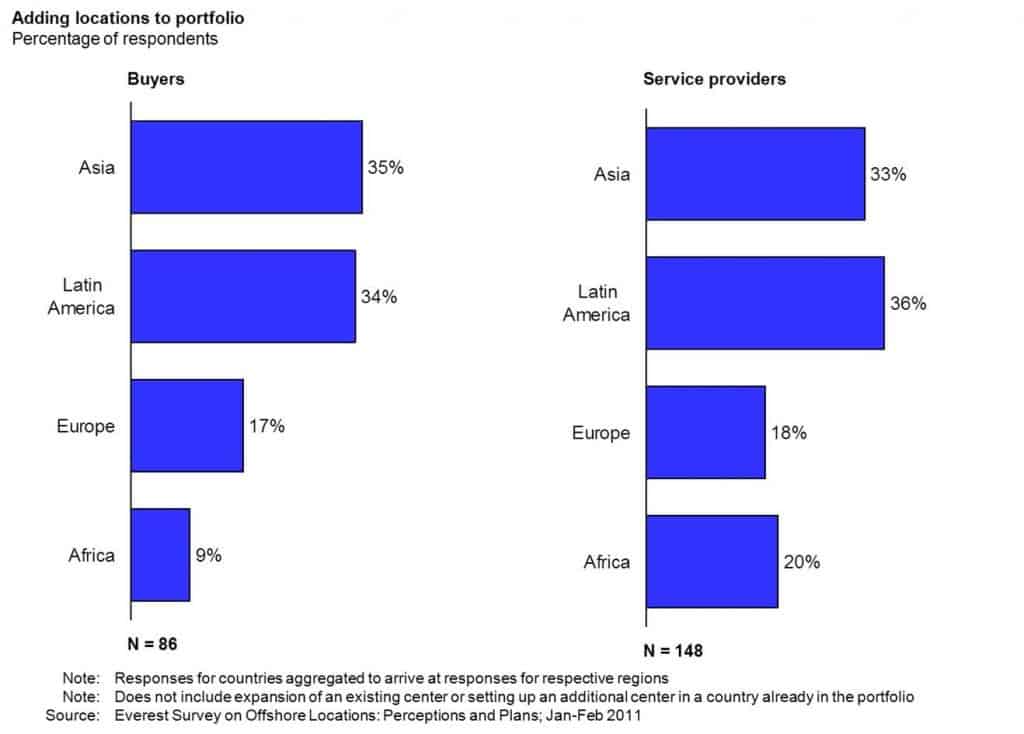
The mandate of Everest Group’s Location Optimization practice is to assist clients with data, insights, and advice on which global sourcing practitioners can rely to make their most critical decisions related to global locations. As we go about conducting our day to day business, three questions underpin the discussions with global sourcing practitioners nine out of 10 times.
What are the key locations for global services delivery?
Which regions are attracting attention and interest to meet the next wave of global services requirements?
How do the key global services stakeholders (buyers and service providers) perceive the next frontier(s) for global sourcing?
In order to build awareness on the trends we are observing across the global locations space at the highest level, we will attempt to provide the answers to these three questions.
First, let’s look at the key regions for global services delivery today. Exhibit 1 depicts our Market Vista Locations Maturity Heatmap, which tracks and compares the level of market activity across global locations. Asia remains the dominant location of the global services installed base by a large margin. This should come as no surprise as the global sourcing story has been pioneered and successfully played out in Asia – India provided the proof of concept for building industrial scale in global services, and the Philippines has rapidly adopted this successful model and opportunity to become a world leader in customer service. The success seen by India and the Philippines has encouraged other locations in Asia to concoct their individual recipes for succeeding in the attractive global services space. For example, China has emerged as a credible option for sourcing R&D and engineering services (read more in Everest Group’s “What is the True Maturity of China’s Offshore Services Market?”) while Malaysia is making concerted efforts to carve out a niche in the shared services space.
Exhibit 1 – Market Vista Locations Maturity Heatmap

Central and Eastern Europe (CEE) and Latin America are the next set of regions beyond Asia in terms of installed base of global delivery. These regions experienced waves of expansion, especially as companies strive to put in place a global portfolio of delivery locations for purposes, such as risk diversification, leveraging technical/language skill sets, 24×7 coverage, regional support, etc. There are more than 10 locations in both these regions with credible evidence of global services activity. Poland (in CEE) and Brazil (in Latin America) are the two large locations that have built credible scale in global services delivery and are recognized as mature locations on our Market Vista Location Maturity Heatmap. Poland has carved out a niche as a nearshore location for servicing Europe in non-voice business processing and IT, while Brazil is recognized for IT talent and an attractive domestic market, in addition to its proximity as a nearshore location for global services. (Read more about Brazil in Everest Group’s “Perspectives on the Maturity of Brazil’s Offshore Services Market.”)
Africa is a relatively new entrant in the global services locations landscape and has three or four locations with nascent global services activity. It presents specific and, at times, niche propositions and opportunities. And its value proposition is now being slowly understood by global investors.
Next, and before we discuss Africa in greater detail, let’s look at the set of locations attracting interest from buyers and service providers to meet the next wave of global services expansion. Exhibit 2 is based on Everest Group’s comprehensive survey of key global services stakeholders and compares regions that buyers and service providers are planning to leverage for setting up new centers. (Read the Everest Group Location Insights detailing buyers’ and service providers’ location-related plans and perceptions).
Exhibit 2: Location Expansion Plans of Buyers and Service Providers

As is clear, Asia figures prominently in the plans of buyers and service providers for setting up new centers. Asia continues to attract interest from buyers and service providers, despite the high installed base of current activity. The Asian locations witnessing sustained interest include India, the Philippines, China, and Malaysia.
The survey results also give a big “thumbs-up” to Latin America. This is corroborated by recent market activity trends that show the region is experiencing activity in establishment of both captives and supplier delivery centers. Key countries that are witnessing increased interest include Brazil, Argentina, Chile, and Mexico.
Let’s go now to one of the most interesting findings from the survey – Africa! Indeed, as many as 20 percent of all respondents from the service provider segment indicated plans to add new countries in Africa to their global delivery portfolio. South Africa seems to be especially popular with service providers, with 10 percent of all respondents disclosing plans to set up a center there. Egypt also figures into the list of leading choices for locating a new delivery center.
So what are the reasons behind this emergence of Africa countries as the next frontier of global locations, especially for service providers?
- They provide a capable (although nascent) low-cost alternative to CEE locations
- They offer scalable language skills and cultural affinity with the developed world. South Africa and Morocco have strong cultural similarity with the United Kingdom and France, respectively. Egypt offers the opportunity to cater to the lucrative Middle East market.
- A foothold in the African region gives service providers the ability to serve domestic African markets, e.g., South Africa for sub-Saharan regions, and Egypt and Morocco for North African markets. Business from local firms and especially MNCs operating in the region present a lucrative opportunity for service providers looking for the next set of clients
In addition to the above value propositions offered by African locations, we can contextualize the motivations for location portfolio expansion from both the buyer and service provider standpoints. Buyers set up captive centers or influence service providers to provide support from new locations primarily to complement their current global locations portfolio in terms of access to specific talent pools for language skills, time zone proximity, to support international business expansion, etc. At the same time, buyers are also sensitive to the complexities associated with a wider geography footprint and, hence, are looking to find the optimum balance of value capture and risk mitigation from global services programs.
On the other hand, Tier 1 service providers usually have a wider frame of reference due to their servicing of multiple clients, and hence are typically more globalized than buyers. In addition, service providers are more open to moving into hitherto unexplored territories due to incessant cost pressures and the need for differentiation. Most of the Tier 1 service providers are already well penetrated in all the major global services theatres and are now looking to explore the African continent.
Although it remains to be seen how much of this enthusiasm will ultimately get converted to any action, the sheer level of interest itself should excite countries in the African continent – South Africa, Egypt, Morocco, and Mauritius – to develop the global services capabilities in their individual countries, sharpen the articulation of their value proposition and differentiation theme, and craft effective marketing strategies to attract global investors.










